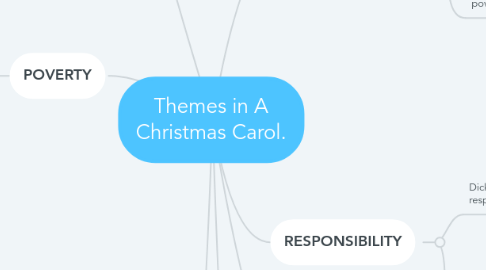
1. POVERTY
1.1. The Cratchits are regarded as Dickens's face of the poor in this novella.
1.1.1. They are living on the edge as Bob Cratchit can only just afford all the family's needs.
1.1.2. Mr's Cratchit's ribbons might be a luxury but they're also a symbol of her desperation to make her dress look new and respectable. She is 'brave in ribbons'.
1.1.3. They are full at the end of their meal, although we have to wonder if this is because they don't have enough to eat the rest of the year; 'nobody said or thought that it was at a small pudding for a large family. It would have been flat heresy to do so. Any Cratchit would have blushed to hint at such a thing'
1.2. Dickens shows us glimpses of poverty even deeper than the Cratchits.
1.2.1. The charity collectors tell us, 'Many thousands are in want of common necessaries'
1.2.2. The charity collectors tell us, 'Many thousands are in want of common necessaries'
1.2.3. Marley's Ghost shows 'a wretched woman with an infant ... upon her door-step'
1.2.4. Dickens places Old Joe's shop in a part of the city which 'reeked of crime, with filth and with misery'. With this scene he shows the corrupting nature of poverty as these thieves enjoy showing what they have stolen to sell.
2. SUPERNATURAL
2.1. The supernatural refers to events or beings that are beyond human or scientific explanation, such as ghosts or seeing into the future.
2.1.1. The narrator works hard to convince us that Scrooge's partner, Marley, is dead and have 'no doubt whatever about that'. There can be no other explanation for his reappearance than that it is his ghost haunting Scrooge.
2.1.2. Dickens also makes use of supernatural to manipulate time and allow Scrooge to travel to his past, present and future and then back again: 'Best and happiest of all, the Time before him was his own, to make amends in!'
3. FAMILY
3.1. Dickens balances Scrooge's isolation with vibrant vignettes that show us the positive benefits of a close and loving family life.
3.1.1. The lonely young Scrooge is rescued by his sister and returns home.
3.1.2. The apprentice Scrooge is part of Fezziwig's Christmas party, along with countless locals 'full of gratitude'.
3.1.3. With the party Fezziwig reaches out to anyone such as 'the boy from over the way, who was suspected of not having board enough from his master' and Dickens wants to show the impact small actions can have.
3.2. For a focus on the immediate family we are offered the Christmas celebrations of the Cratchits and Fred's family, both showing the need to laugh together.
3.2.1. Bob's 'sudden declension in ... high spirits' when he thinks Martha can't come home for Christmas shows us the need for families to be together at key times.
3.2.2. The closeness they have here allows the Cratchits to deal with the foreshadowed death of Tiny Tim in Stave Four.
4. CHANGE
4.1. Dickens emphasizes Scrooge's initial extreme attitudes and rejection of anything that does not make him money.
4.1.1. 'What's christmas to you but a time ... for finding yourself a year older, and not an hour richer'
4.1.1.1. By doing this at the start of novella it allows the reader to clearly see the change in Scrooge's attitude by the end.
5. RESPONSIBILITY
5.1. Dickens felt that every individual had a responsibility for those around them.
5.1.1. Fred describes Christmas as a time when men and women 'think of people below them as if they were really were fellow-passengers to the grave, and not another race of creatures bound on other journeys'
5.1.2. Marley's Ghost tells us 'Mankind was my business'
5.1.2.1. Dickens makes Marley's Ghost succinctly convey the whole message of the novella when he cries, 'Mankind was my business'. This change of focus jolts us as well as Scrooge because we learn that the proper 'business' of life is not about seeking financial reward but having concern over others.
5.1.3. Scrooge learns to take responsibility for the poor, and in doing so redeems himself, 'as good a man, as the good old city knew'
5.2. Dickens had little respect for political or church movements to counter poverty and he saw the new Poor Laws as harsh.
5.2.1. Scrooge shows us the difference a wealthy individual can make, but Dickens also shows us that Fezziwig's small contribution 'The happiness he gives, is quite as great as if it cost a fortune' can make a significant difference to the lives of individuals.
6. EDUCATION
6.1. Dickens emphasizes the value of education through his presentation of the two children, Ignorance and Want.
6.1.1. They are horrific in their appearance. 'Yellow, meagre, ragged, scowling, wolfish'
6.1.2. They serve to illustrate Dickens's belief in the power of and need for education. We are told to 'beware' Ignorance for he is 'Doom'.
6.2. Dickens does not shy away from presenting the most graphic effects of ignorance and deprivation - and makes us think about the role of education in the fight against poverty.
7. ISOLATION
7.1. Dickens demonstrates the need for companionship and company.
7.1.1. Left to himself as a boy, Scrooge finds companionship in stories - 'a lonely boy was reading near a feeble fire' - but as an adult he focuses on making money at the expense of relationships.
7.1.2. The difference between Scrooge at the beginning and the redeemed Scrooge is considerable, and we see that it is not just due to his helping the poor; it is a result of his rejoining society, 'as good a man, as the good old city knew'
7.1.3. Being a second father to Tiny Tim means Scrooge gets some love and support he has been missing or refusing.

